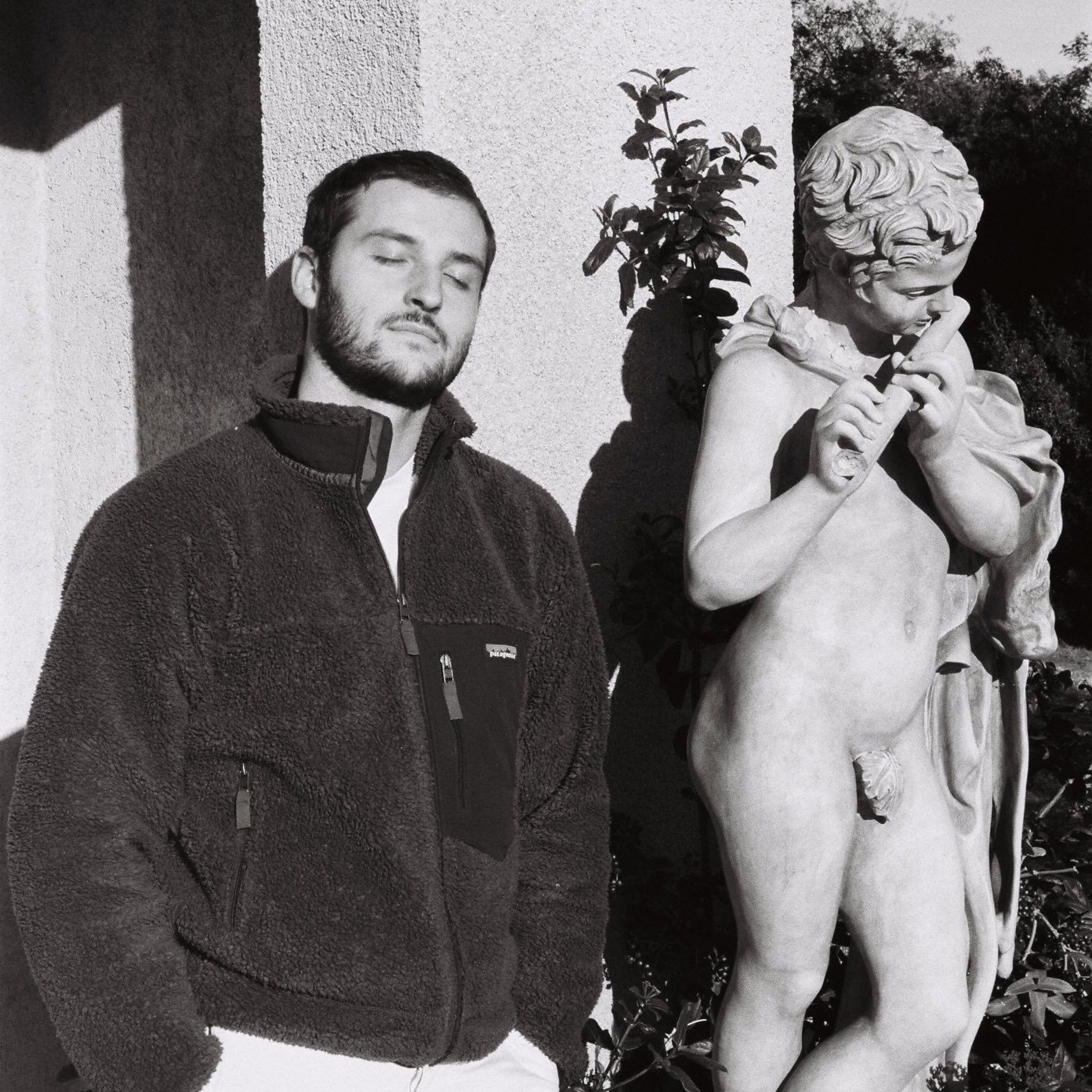Part I: Introduction
I joined a climate-activism campaign in 2022 because of my growing concern for climate-related matters and my background as a tech-entrepreneur drove me to Dernière Rénovation, a KPI-driven, success-oriented non-profit. I am writing this article to help wannabe activists, founders, and anybody interested in the dynamics of non-profit organizations. We are many thinking about launching a social or climate-related organization, or simply thinking of joining one: it doesn’t always go as you would think!
What is Dernière Rénovation
Dernière Rénovation (DR) translates to Last Renovation. It is a non-violent civil resistance campaign demanding one thing only: an ambitious state-sponsored plan for insulating France’s 5 million thermal sieves. 12 million people (on roughly 67 million) live in places falling into this category. Those are flats and houses very hard to heat and dry, thus bringing energy bills up and people’s health down. Actually, very down, at a very expensive health cost for society : 10 billion euros per year according to the French Ministry of Ecological Transition. Energy consumption related to housing generates 20% of France’s CO2 emissions – that’s excluding the building process – and applying Dernière Rénovation’s plan could cut this number by 50% according to experts’ work during the Citizen Climate Convention (CCC), a bold state-backed experiment held in 2019 with the intent of proposing ambitious strategies to cut climate emissions in France.
In summary, founding members of Dernière Rénovation chose this demand for 3 reasons :
- It would bring down a very large chunk of France’s CO2 emissions.
- It would have a drastic impact on millions of people’s quality of life, especially low-income families.
- It has democratic legitimacy as it is a resulting proposal of CCC’s work and a promise of the current French president Emmanuel Macron.
I wrote that Dernière Rénovation is a civil-resistance campaign, which means the organization’s main means of action is disobeying the law. Specifically, Dernière Rénovation uses two main tactics:
- Repeatable ones bearing low judicial risks, called rince-and-repeat tactics.
- Carefully planned ones, bearing higher judicial risks, called media tactics.
In both cases, activists face legal repercussions as they are effectively committing felonies. Dernière Rénovation’s rules of engagement for activists require supporters to own their actions and face their consequences while strictly abiding by non-violence principles, whether they face angry motorists or police forces. Trials are later on used as a means of amplifying Derniére Rénovation’s message.
Rince-and-repeat tactics
Dernière Rénovation rinse-and-repeat tactics have been roadblockades from the very start. This type of action consists of a small group of people (6 to 10) walking into a large road such as a highway and sitting on the asphalt in a line to prevent vehicles from moving forward. A typical blockade will last for less than 25 minutes, with first police units generally arriving minutes after the action starts and larger police trucks quickly following. Activists are lifted out of the road by law enforcement forces, processed, and put in custody for 24 to 48 hours. Most of them used to get out free of charges after this cell time, they now face criminal charges and are systematically sued by prosecutors, facing up to two years in prison and a 7500 euro fine. Tens of Dernière Rénovation activists have been trialed, most received between 0 and 1 000 euros fines, and one got several months in prison suspended sentence.
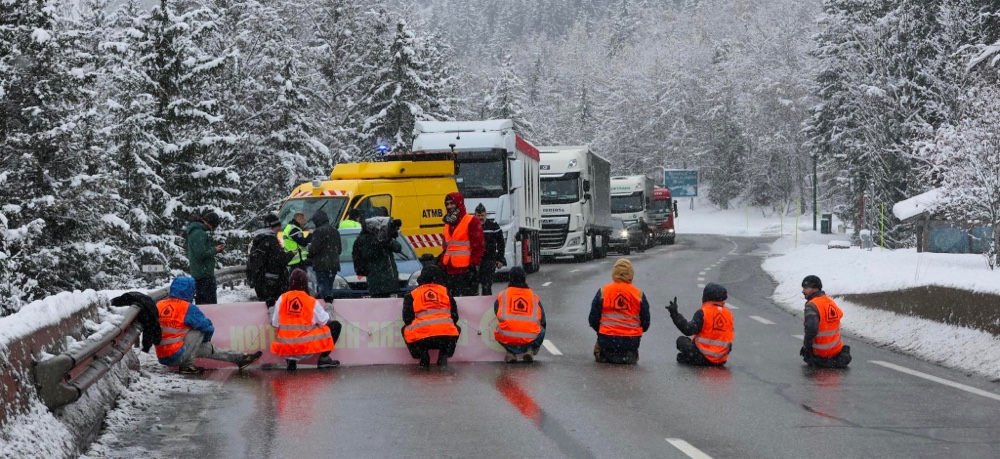
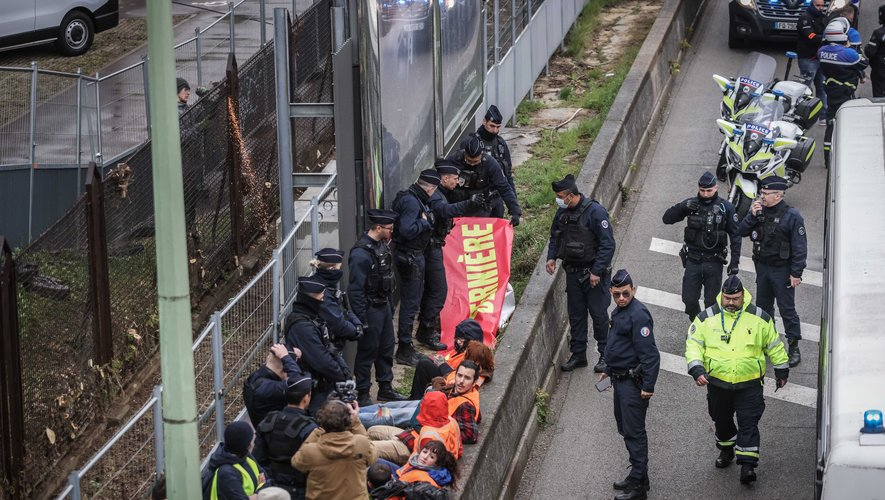
Media tactics
Dernière Rénovation theory of change relies on a positive feedback loop of engagement that could essentially be described in the form of a sales funnel with a few critical steps :
- Get people’s attention.
- Convince some to attend a public meeting.
- Convince some to join an action-training day.
- Have activists register for a rinse-and-repeat action.
DR believes that the more people in step 4, the more disruption will be caused and the more favorable the power struggle with the state will be. Though, even if rinse-and-repeat actions do generate attention, DR also believes media-focused tactics are necessary to quickly generate attention to the campaign and attract new potential supporting citizens. So far, many media-focused actions proved this bet successful, the main ones being :
- Interrupting Roland-Garros French Open semifinals.
- Disrupting the Caesar’s Ceremony at the Cannes Film Festival.
- Covering the Louvres Pyramid with (water-washable) paint.
- Spraying Ministeries headquarters’ entrances with (water washable) paint.
- Blockading the road during the Tour de France cycling competition.
- Lowering the flag atop of the Paris Pantheon.
- Bypassing Macron’s security and confronting him during the biggest public event in France.
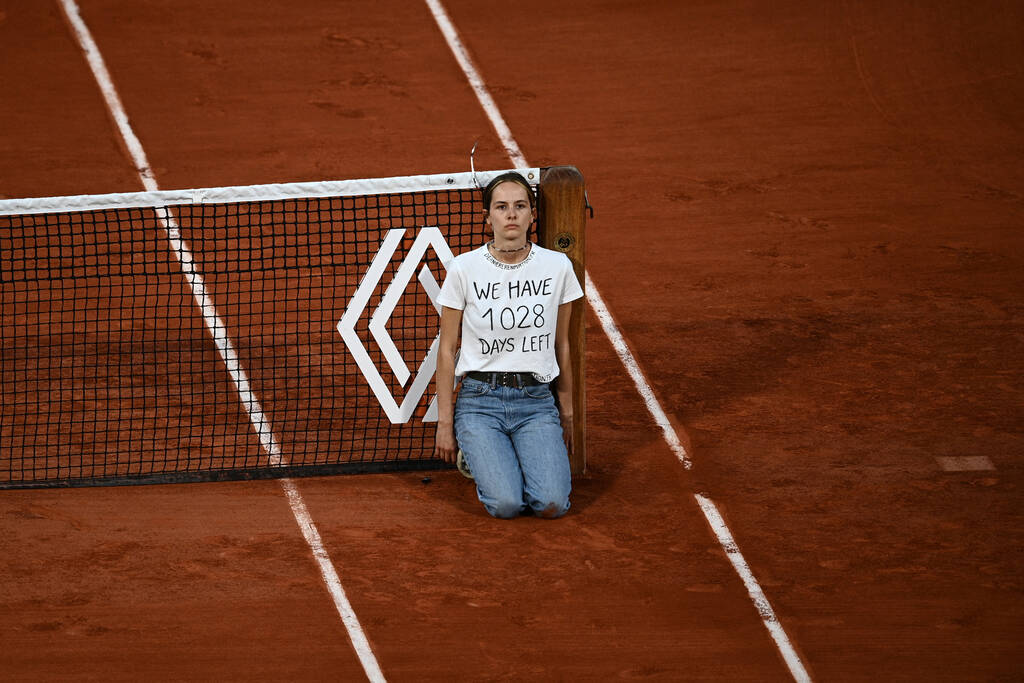
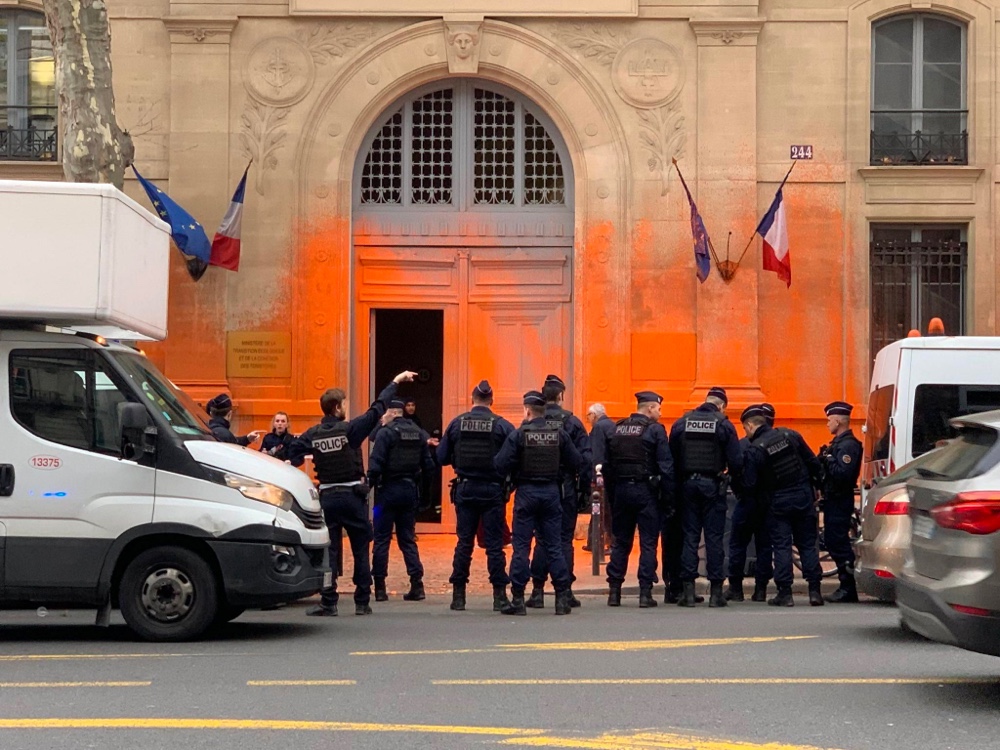
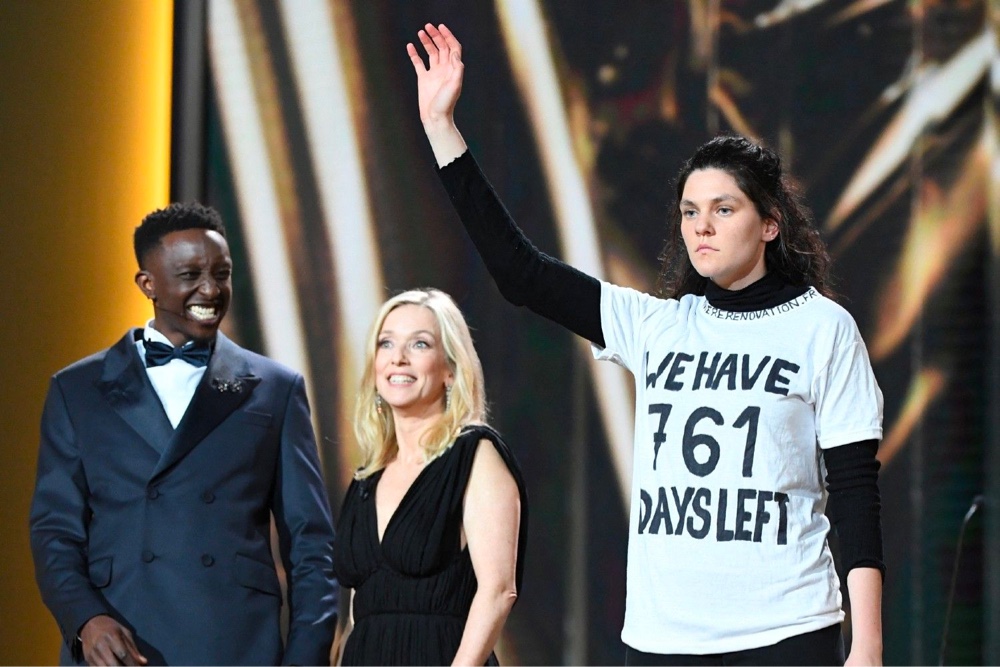
Several of those actions generated hundreds of thousands of visits to DR’s website and translated to noticeable upticks in registrations for public meetings and action training sessions.
State of police repression for activists in France.
Whether they be rinse-and-repeat or media-focused, actions led to activists being systematically arrested, put into custody, and often charged later on. My experience leads me to believe police forces are currently used as a quick and dirty means of punishment for climate activists in France. Contrarily to how climate activists are treated in the U.K., french courts have been rather soft in their sentences while police units are more violent and used as a state tool for discouraging protestors and activists from hitting the road. At a larger scale in France, the general police repression situation is rather grim with new laws being passed granting new tools for police forces :
- Legal and illegal usage of A.I for facial recognition.
- Usage of drones livestreaming protests or equipped with staining liquid sprayers for protesters identification later on.
- Usage of anti-terror units to raid climate activists’ houses.
- Deployment of anti-terror units (not crowd control units) shooting bean-bags munitions during urban riots.
- Delivery of dozens of brand new armored vehicles for crowd control.
France has been criticized by the UN Human Rights Council for its “excessive usage of force” and for its “disproportionate repression” of protesters (among many other things). I believe my country is progressively building a very strong legal and semi-legal arsenal of laws that are and will be used to suppress fundamental civil liberties. The combination of a rather authoritarian way of exercising power, never seen before technical means and growing social unrest is a dangerous recipe. Far-right party Rassemblement National has never been so close to winning the general elections and is now in a position to win the presidential elections in 2027 or 2032. Laws and tools allowing for strong police and legal repression are a dangerous threat in the hands of Macron’s liberal government, they will be an existing one in the hands of Marine Le Pen’s Rassemblement National party.
Basic structure elements of Dernière Rénovation
DR is a member of a larger network of campaigns called the A22 Network, a boilerplate for launching climate-related civil resistance campaigns around the world and getting easier access to international funding, especially from the Climate Emergency Fund. Sister campaigns in the network include Just Stop Oil in the UK and Letze Generation in Germany.
The campaign itself is comprised of two main teams: the national team and local groups. This distinction is often found in the business world with many retail industry companies having both national headquarters and local branches or agencies. As DR aims to generate mass civil resistance waves in France, it’s built to make it as easy as possible for willing people to join their nearest local group and start contributing to the campaign, fulfilling mobilization missions such as :
- Ringing sessions (i.e. calling people who wanted to know more, didn’t follow up after attending a public meeting or other cases).
- Distribution leaflets in the streets.
- Putting up posters in the city.
A fraction of the supporting people will have more time available and be willing to get even more engaged than when fulfilling those local group mobilization missions. In that case, they qualify to join the national team. Those people are identified when they proactively apply, some are headhunted to fit the campaign’s needs. Without getting too specific on the internal structure of the national team, one good approximation would be a generic company’s structure with specific additional teams for DR’s “business model” that is mobilizing people through civil resistance actions :
- Strategy and coordination team.
- Admin team for finances, tech, law departments, and HR.
- Mobilization team.
- Action design team.
I have fulfilled many roles during my time in the organization, I saw it grow and at some point, I became part of the coordination team.
Why is Dernière Rénovation now shutting down
After 20 months of existence and in accordance with its campaign DNA, Dernière Rénovation is disbanding. The organization considers it reached much of what’s reachable :
- 1.6 Billion Euros annual increase in the state-sponsored program for insulating thermal sieves.
- A stronger financial support from the state for struggling households.
- A shift in mentalities around this topic, switching from “a technical matter to a political one” according to a C-level at the Abbé Pierre Foundation, fighting for thermal renovation for decades.
Reaching those milestones in addition to the urgent need for a political shift on other topics led the strategic team to announce the disbanding of Dernière Rénovation and a transition phase for the organization to come back with another winnable demand in the next few weeks.
Part II: Key learnings
💡 I tried keeping a factual approach and neutral tone for this article introduction, but I will now get more opinionated. Feel free to challenge my takes in a civil way by email. For security reasons, I sometimes mention topics without getting too much in details. Still, please reach out if you want to further discuss.
Founders and leaders are even more challenged than in a for-profit organization
How are founders and leaders considered in a civil-resistance campaign like Dernière Rénovation that doesn’t generate monetary value to be distributed and that is not a capitalistic structure with shares held by founders or investors? I beheld that the lack of authority derived from the usual rules of capitalism is putting the founders under higher pressure for two reasons.
First, free-enterprise capitalism relies on an extremely important and arguably unfair axiom: capital holders get to reap profits generated from business activities. The monetary tangible added value generated by doing business goes back to founders, owners, and investors depending on how the company grew. Some people think that’s wrong, some think it’s right, in any case, stakeholders (say employees) have theoretically the possibility to move to another company where value is better distributed should they be unhappy with their current situation. This deal is more or less accepted in capitalist societies and it gives capital holders legitimacy. This combined with the power to fire people, effectively cutting their revenue source, gives founders or C-levels the means to work without getting too much challenge from their teams. In civil resistance movements, those rules simply don’t apply. That is what I call the material criteria.
Second, climate activists are very much leftists in France. Not all but a large part of my fellow activists are anywhere from social democrats to anarchists or Trotsky-style anti-capitalists. That means many members of Dernière Rénovation are not fond of power structures that rely on how much capital individuals are holding. That also means they will refuse to see value extracted from the collective work be collected by a small number of individuals, and even if there is no monetary value to be extracted from Dernière Rénovation, that doesn’t mean there is no value to be extracted at all. Among other things, non-profits generate fame for their leaders, media exposure, a chance for personal branding development, connections to powerful individuals, or career opportunities for some activists. So there is very much value to be extracted and a strong refusal for its monopolization by leaders. This is what I call the conceptual criteria.
The combination of both those criteria, in the context of a fast-growing structure whose members experience high stress contributed to generating a lot of distrust from the base of members to the leaders of the campaign. That’s obviously on top of some arguably poor strategic decisions by young climate activists who a paving the way and learning on the job. Dernière Rénovation was able to overcome very strong crises in leadership trust by progressively setting democratic processes, means of free expression from members of the team, and counter-power organs with specific mandates of keeping leaders in check for potential power abuses.
Fundraising has to be thought-through from the early days
DR is largely funded by money coming from the Climate Emergency Fund (CEF), a quite self-explanatory organization whose most famous donator is Don’t Look Up director Adam McKey. This is both a tremendous chance and a risk. In DR’s case, easy access to money led us to believe money would never be an issue. We made the mistake of getting a bit spoiled and not prioritizing fundraising activities amongst the tons of other activities we had to plan and execute. Two risks emerged from this mistake :
- Building increasingly critical dependence on one source of funding.
- Missing out on large amounts of money not raised during peaks of media attention, i.e. high opportunity costs.
Setting up a robust fundraising strategy and process requires a lot of work, trial, and error to understand our organization’s supporters’ demographics and drivers. From getting people’s attention to convincing them to donate to nurturing them, acquiring, upselling, and caring for donors is very much similar to how startups interact with their customers. I believe the donor’s track has to be seen as a funnel with non-profit organizations like Dernière Rénovation measuring acquisition, churn, average donation, and other KPIs. Specifically, civil-resistance climate campaigns using media-focused tactics experience strong bursts of media attention and must be ready to handle them to extract as much value as possible from those events.
We at Dernière Rénovation were not prepared enough, nor did we have a strong and clear enough donator track. Our sister campaign Letze Generation runs on roughly 80% of donors raised funds, we only got to roughly 40% yet. We missed out on quite a lot of funds. So whether you’re broke or lucky enough to have access to funds, start designing, testing, and implementing a fundraising strategy as soon as possible and ramp it up as you go.
Illegality makes everything more complex
Organizations like DR face two types of legal pressure: one on its members as individual activists breaking the law, as I previously described, and the other on the structure itself. Most countries have special laws designed to repress organized crime and France is no exception. Though it did not happen during my 18 months as a member of the organization, some prosecutors could try and sue DR as a criminal organization facilitating people committing crimes. That hypothesis is the biggest question mark in the life of members of the organization as one has virtually no way of knowing the police are building a case. Each day could be the one when a police unit busts open a member’s apartment door. It has happened to climate activists who engaged in the destruction of property and, in some cases, to ones who only did non-destructive, non-violent actions.
I witnessed that activists do not glamourize those risks. Some joke about it to release the very real pressure that they feel, others are working on contingency plans should raids happen. This environment does make running such an organization a more difficult task. People are tense, especially during high-intensity action phases. The stress accumulates, the fear of being followed by plainclothes police units, of facing fines, raids, phone tapping, or prison time comes at a very high emotional cost and wears on people, leading to higher churn and increased risks of interpersonal tensions. Civil-resistance organizations must account for this reality and implement ways to take care of their members: speaking groups, mandatory resting days, security training, legal training, digital hygiene training, etc.
Besides the emotional weight, using illegal means to demand climate policies also requires organizations like DR to use the right productivity and communication tools. Large, mainstream corporations like GAFAM are known to work with police forces and to hand over loads of data per administrative request. Depending on how illegal organizations’ sponsored actions are, some groups will need much tighter operational security than others. A group engaging in sabotage would face extreme police means to infiltrate it and collect evidence. Usage of NSO’s Pegasus-like tools is proven amongst police forces in many Western countries, in some cases against climate organizations. In France, the DGSI (our counter-espionage and counter-terrorism agency) was called to crack a climate activist’s phone in at least one proven case.
Those opsec adjustments disrupt people’s habits and may create steep learning curves for newcomers used to GAFAM tools (say Google Sheets for example). It is critical for civil resistance groups to assess how illegal their activities may be, and to adjust in consequence both when it comes to choosing their technological stack and work processes and when it comes to training their members. People interested in developing civil resistance movements should bear in mind, though, how little an average person knows about security best practices, real-world ones, and digital ones. Most people don’t understand how capable the police forces are, or why you can’t rogue-click any incoming email link, not even the actual purpose of using a VPN. This is the same as in a company but with different risks at stake.
An organization failing to have an impact on the outside world cannibalizes itself with internal fights
Activists share common traits, at least from my experience at Dernière Rénovation. Even though my peers came from a very wide variety of social and economic backgrounds, most of us had several of the following characteristics :
- A very strong drive to contribute to positive change in the world.
- Loads of determination and energy.
- High tolerance to fear and risk.
- An emotional relationship to the cause, a sense of urgency about the state of the climate.
Those traits are very powerful tools and allow members of DR to do lots of work in a rather short time and a very stressful environment. During the long first part of the campaign’s life (roughly one year), we had a great momentum fueled by activists leveraging their personal qualities and common traits. This was an incredibly empowering period, more and more people were getting onboard, attending public meetings, getting trained, and sitting on roads. It was also beautiful, exhilarating even, to witness the very rapid growth of the organization, a feeling founders or early employees of successful startups might recognize. Then we suddenly faced both legal changes making it harder for activists to engage in civil-resistance tactics and a sudden shift in media attention in the light of the emergence of protests and riots against a French pension reform bill.
The organization lost its momentum, members lost trust in our leaders, and things got heated rather quickly. Members of the team started losing faith in our collective ability to create change in the outside world and rather used their energy to try to change the organization from the inside. Problems that may have existed before (and for sure many existed) quickly became internal casus bellis, tension arose on governance, sharing of power, lack of democracy, and vision, and arguments erupted because of increased inter-personal disagreements. The positive compound effect of having fierce people with a lot of drive in a group of similarly built activists had turned into a self-destructive process that proved extremely difficult to stop and fix, though we did manage to.
I saw firsthand how our inability to handle that momentum drop we experienced directly contributed to lowering the group’s tolerance for internal issues that had been left rotting aside because we believed we had better work to do than fixing our organization. I learned two things :
- An organization’s group energy needs to be funneled or it will dissipate internally with loads of damage.
- Fixing a house roof before it rains is very much easier than when shit hits the fan.
Rapid growth is extremely challenging and it is sometimes necessary to refuse it
DR went from roughly 5 founders located in Paris in April 2022 to more than 200 volunteers in 10 different cities working anywhere from 8 hours per week to full-time for the organization six months later. While this happened, the people in charge had to figure out how to decide to open branches in French cities, how those branches should be structured, how to handle recruiting and onboarding newcomers, how to maintain a homogenous culture across the organization, etc. We collectively spent hundreds of hours tracking those challenges, and a lot of this effort ended up being in vain.
Of all the challenges, the geographical growth was probably the largest to handle. We had momentum and a strong presence in national-wide media: so people from many cities in France wanted to get on board and help us reach our demand. DMs were pouring in on Instagram, e-mails, and word of mouth, people wanted to contribute. We tried to reap the fruits of growth and said yes every time we felt safe enough to. We recruited tens of newcomers without proper onboarding, we opened cities lacking staff because very driven people there wanted to create their team there. This extremely time and resource-consuming job paid though, as we managed to open our 10 different teams in 10 different cities…right on time for the momentum drop I described earlier. We had grown for growing without a clear plan of what we would do should an external factor jam our beautiful machinery. As we were forced to slow down, we now had a complex, distributed, resource-consuming structure with tens of men and women waiting for the machine to start again. The national leadership team had to face the same challenges I described in my previous point, with the new factor of distance between Paris and our local teams. People started getting at DR for slowing down, frustration grew amongst our local teams as we tried to organize meetings, trainings, and actions with less success than before. Local team leaders endured as they could and then dropped out one after the other. We were losing people on whom we had spent tens of hours in recruiting, training, and onboarding. Because we now had the structure and because we had spent so much on those leaders, we doubled down on finding new ones to replace their predecessors in what could be summarized as gambler’s fallacy.
Again, I learned two things :
- Any organization should be ready to refuse growth to a certain extent in the first place.
- Later on, it should be ready to cut its losses quicker instead of persisting on a dead end.
Organisation culture is critical
As we experienced the numerous challenges mentioned earlier in this post, one key factor of failure stood out as an important part of why we were struggling. This factor was organization culture, specifically the lack of it having been made formal and having been passed on to newcomers. At the creation of DR, the founders wrote down several documents on how they envisioned the way the organization should function culturally speaking. How people should communicate with each other, what rules and tools should we use to work together in meetings or asynchronously, some values newcomers should accept and adopt to get into the group, etc. This work was great, it was much more than what I typically saw in startups I founded or joined, as this culture topic is often disregarded or put aside waiting for a fundraising event that will bring additional resources to spend on what can appear secondary compared to topics more directly linked to business. Most people didn’t read the docs though (would you ?), it was pages of well-presented Google Docs that mostly sat on a drive happy to enlighten the occasional curious reader or someone who would have been referred to those docs after failing to understand or respect a key element of our shared culture. That culture was still passed around, living in people’s minds and behavior because in the early months was still mostly working in Paris and comprised of less than 20 people. We shared a lot of synchronous moments: days working at the office, climate-related events, post-public meetings drinks, etc. Some people embodying the culture were there at work or around work to share their vision, to practice the behaviors they expected from others, and to help people around them grow. That stopped when we experienced our fast & furious growth phase: newcomers from all around France got on board, lots of them without proper human training or interactions with historical members of the crew. Those new members of the team then had only static, passive resources to refer to, and most did not read the docs either and we started seeing our culture drift. We still had a theoretical culture, written down and upheld by historical members of the organization, but the actual culture understood and practiced by a larger and larger part of our colleagues was now very much different. This is a problem for two reasons :
- The culture goes from being formal to being informal, undocumented, and hard to transmit or even enforce as I have no actual support to do so.
- Tenants of the older, now theoretical culture try to make others behave per what they believe is the rule of law, the closest thing the organization has to a constitution. That brings clashes within the group since it brings legalities to an otherwise organic experience of the organization’s culture. It is seen as picky and illegitimate by many, and even though referring to our documented culture still worked to have people change their behavior during this period because they had a lot of goodwill, the situation was getting unbearable.
We did have an onboarding process in place. Placed after the recruiting process, it consisted of an hour-long call helped by a person dedicated to this job and gathering all the new attendees of the week. It was a way to transmit fundamental information about the structure and the culture of Dernière Rénovation, and a way of having newcomers feel they belonged to a team by mutualizing the calls. This call was very well received by people joining. They did feel it was a great connection to the national team whose members held the call, relieved to receive top-down, structured information and to have the opportunity to meet fellow activists.
Our solution to fixing this issue was to create a working group on a culture focused on a several-point process :
- Investigate and describe our current problems.
- Interview members of Dernière Rénovation to understand what issues existed around culture.
- Consult the whole team to collect quantitative data on adhesion on different cultural topics (communication between members, level of brutal honesty expected, working hours, right to disconnect expectations, etc.)
- Propose a list of values in the form of sentences, each associated with a larger documentation on how to understand it and behave in consequence.
- Design a culture module as part of a to-be-created full onboarding day.
An example of a sentence that became one of our cultural pillars is: express yourself with honesty and lucidity. It means we collectively decided we would try our best to be honest, even in moments when we knew it might be difficult to receive while keeping in mind other’s feelings and taking into account the impact of our words on others. The fact that this process existed was extremely relieving for members of the team, first for the symbol it sent that leaders had understood there was a problem to be solved, and then because it called for members’ participation in the design of our future values. The addition of later teambuilding seminars and presentations of this work resulted quickly in an appeased mood in the team and an increase of well-being among us. As this work is recent and the campaign is now shutting down before we managed to implement the full-day onboarding sessions, I cannot yet tell if the culture is now both understood and practiced by recruits. We will see in the next one since this work will still apply as the team is moving on to another demand.
A few last words
With this post, I tried to gather the key learnings I had from my time at Dernière Rénovation. As time passes, I will probably identify other points worth sharing. I believe a lot of those learnings apply to both civil resistance organizations and plain, simple law-abiding organizations. Working on this project has been extremely rewarding, I discovered a totally different world, new ways of working, and incredibly driven people, and felt more hopeful about our collective ability to avoid climate catastrophe. It was also very challenging at some points, hard to bear even, but still worth it. As I reflect 18 months later on who I was before attending my first public meeting, I’m grateful I dared put myself in motion and try something new. Let this motto be with me in 2024!
💡 If you want to discuss this post, send me feedback, or anything else you can contact me at hi@lhostis.me
Who am I and why did I join a climate organization
My name is Guillaume L’Hostis. I am a French citizen, 28 years old. I come from a middle-class family, lacking nothing essential, and never living in opulence. I graduated from one of the top business schools in France and lived my student life in Paris. After graduating, I used to work in the SaaS industry as a start-up founder. I co-founded, bootstrapped, developed, and sold my company during my early twenties. Our acquirer, a Silicon Valley-based startup hired my team as part of the deal and I kept working for them for roughly two years.
During that time, I was growing a larger and larger interest in climate-related issues, though I would fly frequently to close and distant destinations, sometimes for very short periods of stay ; 3 days to negotiate my acquisition deal in San Fransisco (2 to 4 tons of CO2e depending on sources), 5 days in the U.A.E for pitch-competition finals (1.4 to 2.1 tons of CO2e; yes we won). This growing concern reached a tipping point (pun intended) during the year 2020 for two reasons :
1. On a much personal level, I faced the reality of my flying-induced emissions which I had dismissed using fallacies like an “Airbus A320neo burns less fuel per passenger per kilometer than any car”. I faced that, considering how frequently I flew, the distances I was flying and my overall lifestyle translated to a total of more than ten times the 2 tons of CO2e emitted per year a french national should aim for to match COP21’s goals (a.k.a the Paris Climate Agreement).
2. I fell into a severe disbelief state after selling my company. I had fought for money and spent every day of the week working to build and grow my business. Now that I had reached a lot of my goals at once, I had the chance to reflect on the motives that had fueled my passion and channeled my work capabilities during the previous years of my life. I had fought for money, fame, pride, and recognition. When considering if I should go back to building a company, I questioned the overall startup environment I was in. The conclusion was grim and full of guilt: a very large part of so-called ‘startups’ are not disrupting much, nor providing lasting value to society. So-called entrepreneurs are simply playing a game, the largest RPG ever created. I could stay in that game, aim for a larger financial exit at the draw of cards; or I could admit that I needed to connect myself to a greater good, get out of this game, and contribute to something that would be beneficial for my fellow living humans.
I could have chosen to build a sustainable business, away from the field I was in before, or to get into politics, to roam the seven seas on a sailboat. Though, life sent me an unexpected opportunity in the form of a young woman disrupting the French Open tennis semi-finals (Roland-Garros for y’all french lovers). I had been looking around for climate organizations to join, but none appealed to me. Some were seemingly too far-left, others too distant from my socio-economic background. The woman at Roland-Garros though, was from an organization I had never heard of: Dernière Rénovation.
